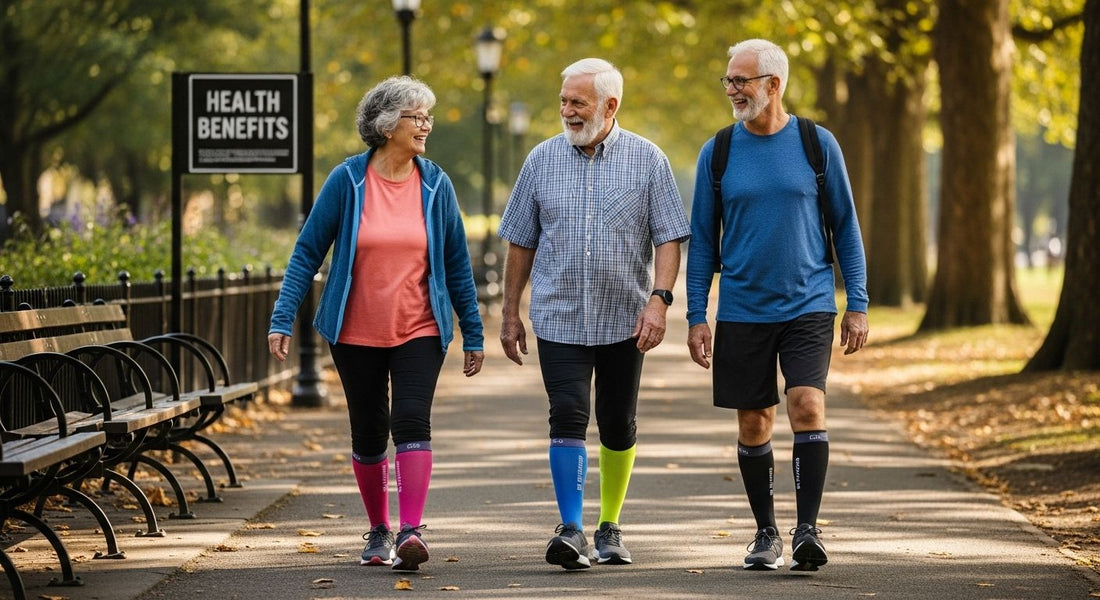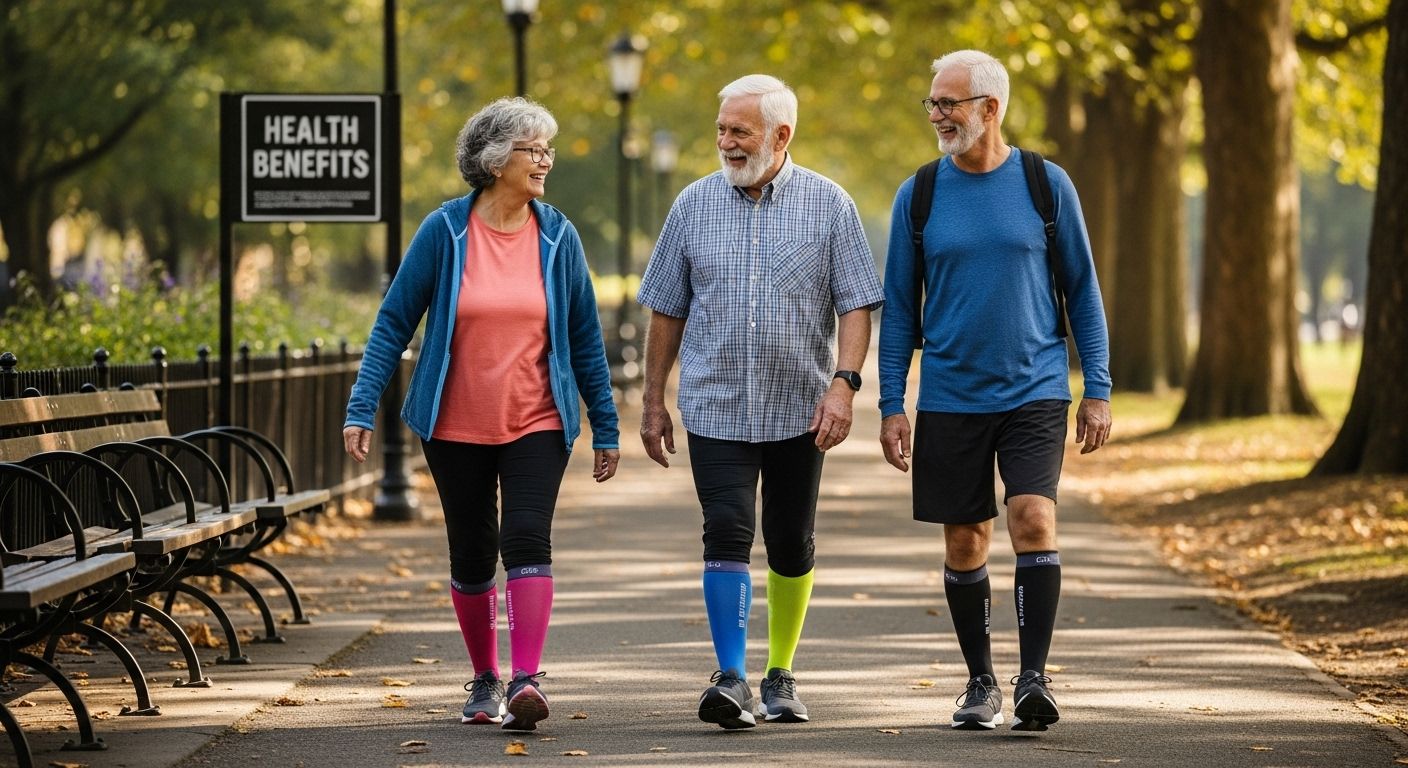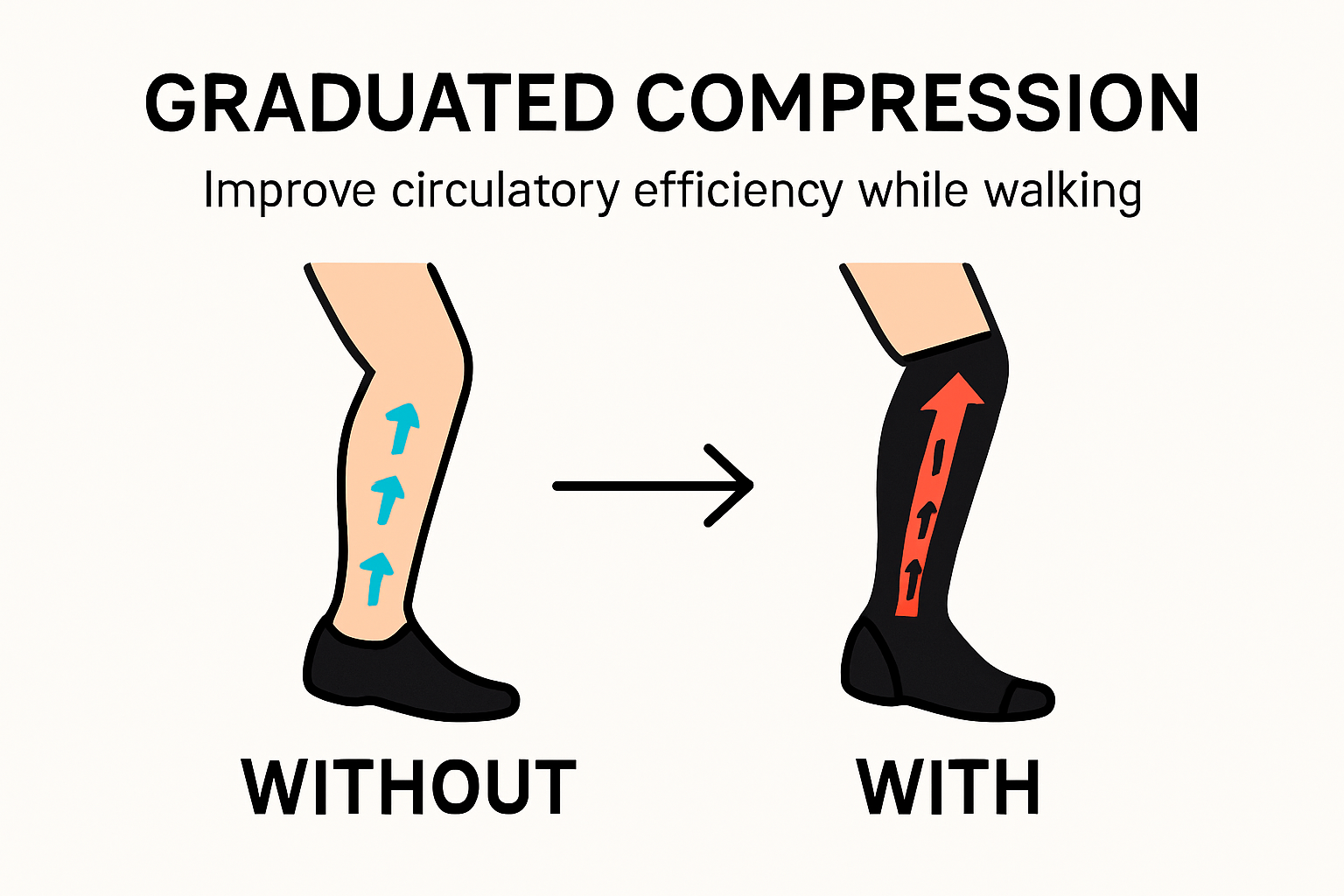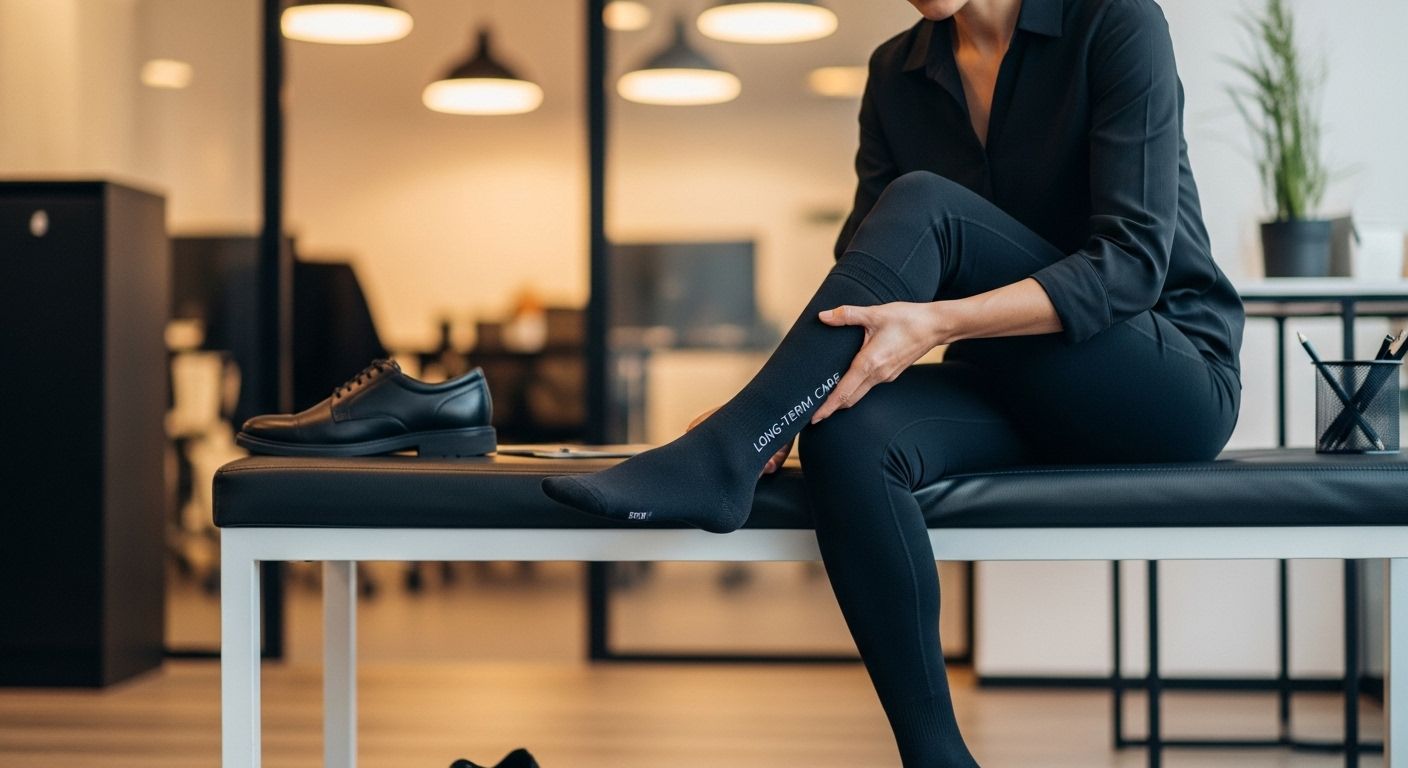
Compression Socks for Walking: Health Benefits and Top Uses 2025
Share

Compression socks might look like ordinary athletic gear for walkers and runners, but their real power is hidden in the details. Experts have found that wearing compression stockings during walking can reduce leg swelling by up to 40 percent. That sounds impressive already and yet the biggest surprise is how these socks also boost balance and improve muscle performance. Turns out the comfort is just the beginning and the real benefits go much deeper with every step.
Table of Contents
- How Compression Socks Help While Walking
- Who Should Wear Compression Socks For Walking
- Choosing The Best Compression Socks For Your Needs
- Tips For Safe And Effective Use During Walks
Quick Summary
| Takeaway | Explanation |
|---|---|
| Compression socks improve circulation while walking | They reduce leg swelling and enhance blood flow back to the heart, making walking more comfortable. |
| Beneficial for specific groups of individuals | People with circulatory issues, and pregnant women, can greatly benefit from wearing compression socks during walks. |
| Choose the right compression level for effectiveness | Compression levels range from mild to medical-grade, with 15-20 mmHg being suitable for general use and walking. |
| Proper application is crucial for comfort | Ensure socks are applied smoothly without bunches or twists to maximize their supportive qualities during movement. |
| Regular maintenance extends the life of compression socks | Wash after each use and replace every 3-6 months to maintain optimal compression and support. |
How Compression Socks Help While Walking
Walking is a fundamental form of exercise that offers numerous health benefits, but for many individuals, leg discomfort and circulation challenges can impede their walking experience. Compression socks provide a strategic solution to enhance walking performance and comfort, addressing multiple physiological aspects of movement.
Improving Circulatory Efficiency During Walking
When you walk, compression socks work like a supportive mechanism for your circulatory system. Research published in the International Journal of Vascular Medicine demonstrated that wearing compression stockings during walking significantly reduces leg edema. The graduated pressure design of these socks creates a unique physiological response that promotes blood flow from the lower extremities back toward the heart.
The strategic compression helps counteract gravitational pull, preventing blood from pooling in the legs and reducing the risk of swelling. By applying gentle yet consistent pressure, compression socks assist the body’s natural venous return mechanism. This means your muscles can work more efficiently, reducing fatigue and potential discomfort during extended walking sessions.

Enhanced Neuromuscular Performance
According to research in BMC Sports Science, Medicine and Rehabilitation, compression socks do more than just improve circulation. They enhance sensory feedback, which positively impacts standing balance and walking performance. The tight fabric provides additional proprioceptive input, meaning your nervous system receives more precise information about leg position and movement.
This enhanced sensory input can lead to improved neuromuscular control, potentially reducing the risk of minor injuries and improving overall walking mechanics. For individuals with balance challenges or those recovering from previous leg injuries, this neurological benefit can be particularly significant.
Supporting Long-Distance and Therapeutic Walking
Harvard Health Publishing confirms that compression socks are beneficial for individuals with various circulatory conditions. For walkers managing chronic venous insufficiency, varicose veins, or those prone to leg swelling, compression socks offer a practical intervention.
Whether you’re a recreational walker, a fitness enthusiast, or someone managing a specific health condition, compression socks can transform your walking experience. They provide targeted support that goes beyond simple comfort, actively contributing to better leg health and walking performance.
For those interested in selecting the right compression socks for their walking needs, our comprehensive guide can help you make an informed choice.
Who Should Wear Compression Socks for Walking
Compression socks are not a one-size-fits-all solution but offer targeted benefits for specific groups of individuals. Understanding who can most benefit from wearing compression socks during walking helps optimize their health and performance.
Individuals with Circulatory Health Challenges
According to the Cleveland Clinic, compression therapy is recommended for people experiencing poor blood circulation and related conditions. Individuals with chronic venous insufficiency, varicose veins, and deep vein thrombosis (DVT) can significantly benefit from compression socks during walking. These medical conditions often result in leg swelling, discomfort, and reduced blood flow, which compression socks can help manage.
People with a history of blood clots or those at higher risk of developing circulatory complications should consider compression socks as a preventative measure. The graduated pressure helps improve venous return, reducing the likelihood of blood pooling in the lower extremities and minimizing potential health risks associated with prolonged standing or walking.
Professionals and Active Individuals
Research from Yale Medicine highlights that certain professions and lifestyle factors increase the need for compression socks. Professionals who spend extended periods standing or sitting, such as healthcare workers, teachers, retail employees, and office workers, can benefit from compression socks during walking and daily activities.
Athletes, runners, and fitness enthusiasts also find compression socks valuable. These garments support muscle recovery, reduce muscle vibration, and potentially decrease fatigue during walking and other physical activities. By providing additional support and improving circulation, compression socks can enhance overall walking performance and comfort.
Pregnancy and Special Health Conditions
Harvard Health Publishing emphasizes that pregnant women are particularly good candidates for compression socks. Pregnancy increases the risk of leg swelling and venous complications due to hormonal changes and increased blood volume. Compression socks can help manage these challenges, providing relief and supporting healthy circulation during walking.
Additionally, individuals recovering from leg injuries, those managing orthopedic conditions, and people with diabetes who experience peripheral circulation issues can find significant benefits from wearing compression socks. The targeted pressure helps support muscle and joint stability while promoting better blood flow.
To help you quickly identify which groups benefit most from compression socks for walking and their primary needs, here’s a summary table:
| Group | Why They Benefit from Compression Socks | Key Needs Addressed |
|---|---|---|
| Individuals with circulatory challenges | Improves venous return, reduces swelling/discomfort | Enhanced circulation, edema control |
| Professionals who stand/sit long hours | Prevents leg fatigue and swelling | Comfort, energy, swelling prevention |
| Active individuals, athletes | Supports recovery, reduces fatigue | Muscle support, faster recovery |
| Pregnant women | Reduces swelling, supports veins | Safe swelling control, improved circulation |
| Individuals with special health needs | Aids in condition management and stability | Joint support, gentle compression enhancement |
Choosing the Best Compression Socks for Your Needs
Selecting the right compression socks is crucial for maximizing their health benefits and ensuring comfort during walking. The process involves understanding various factors that contribute to finding the perfect pair tailored to your specific needs.
Understanding Compression Levels
According to Healthline, compression socks apply gentle pressure to promote blood flow from the legs to the heart. The effectiveness of these socks depends primarily on their compression level, measured in millimeters of mercury (mmHg). Different compression levels serve different medical and lifestyle purposes.
Typical compression levels range from mild (8-15 mmHg) to medical-grade (20-30 mmHg and 30-40 mmHg). Mild compression is suitable for everyday use and light prevention, while higher grades are recommended for specific medical conditions. For walking and general activity, 15-20 mmHg compression provides a good balance of support and comfort. However, individuals with specific health concerns should consult healthcare professionals to determine the most appropriate compression level.
Here’s a comparison table outlining the main types of compression levels and their recommended uses based on the article content:
| Compression Level | Pressure (mmHg) | Recommended Use |
|---|---|---|
| Mild | 8-15 | Everyday use, light prevention |
| Moderate | 15-20 | General walking/activity, mild swelling |
| Medical-grade (lower) | 20-30 | Circulatory disorders, varicose veins, DVT |
| Medical-grade (higher) | 30-40 | Severe medical conditions (by physician’s advice) |
Fit and Material Considerations
WebMD highlights that graduated compression stockings work best when they are precisely fitted. The socks should be tightest at the ankle and gradually decrease in pressure up the leg, which helps increase blood flow velocity and prevent blood pooling. Proper measurement is critical to ensure the socks provide optimal support without causing discomfort.
When selecting materials, consider breathability, moisture-wicking properties, and durability. Synthetic blends like nylon and spandex offer excellent elasticity and support, while natural fibers like merino wool can provide additional temperature regulation. The right material can make a significant difference in comfort during walking, especially for individuals who experience excessive sweating or have sensitive skin.
Specific Needs and Lifestyle Factors
Harvard Health Publishing emphasizes the importance of matching compression socks to individual health conditions and lifestyle requirements. Factors such as occupation, physical activity level, existing medical conditions, and personal comfort preferences all play crucial roles in selection.
For athletes and active walkers, look for compression socks with additional features like targeted cushioning, arch support, and seamless construction. Those with diabetes or circulatory issues might require special designs with extra padding and non-restrictive tops. Pregnant women and professionals who stand for long hours might benefit from different sock styles and compression levels.
Explore our comprehensive guide to finding your perfect compression sock fit, ensuring you make an informed decision that supports your health and walking performance.
Tips for Safe and Effective Use During Walks
Compression socks can be a powerful tool for enhancing walking performance and supporting leg health. However, maximizing their benefits requires understanding proper application, maintenance, and usage techniques.
Proper Application and Wearing Techniques
Harvard Health Publishing provides critical guidance on effectively using compression socks. The ideal time to put on compression socks is in the morning when leg swelling is minimal. Use smooth, gentle motions to avoid creating wrinkles that could restrict circulation. Consider using rubber gloves to improve grip and minimize potential skin irritation during application.
Ensure the socks are smoothly pulled up without twisting, with the graduated compression evenly distributed from ankle to calf. Avoid rolling or bunching the fabric, as this can create pressure points that counteract the intended therapeutic effect. For individuals with limited mobility, using a donning device can help achieve a proper, comfortable fit without straining.
The following table provides a step-by-step overview of proper compression sock application techniques mentioned in the article:
| Step | Application Technique | Key Tip |
|---|---|---|
| 1 | Apply in the morning | Legs less swollen for optimal fit |
| 2 | Use smooth, gentle motions | Avoid wrinkles that may restrict circulation |
| 3 | Consider rubber gloves for grip | Minimizes risk of skin irritation |
| 4 | Ensure sock is evenly pulled up, no twisting | Promotes even pressure and comfort |
| 5 | Do not roll or bunch fabric | Prevents harmful pressure points |
| 6 | Use a donning device if needed | Helpful for those with limited mobility |
Monitoring Comfort and Physical Response
Research from the Journal of Occupational Health highlights the importance of paying attention to your body’s response when wearing compression socks during walking. While these socks are designed to support circulation and reduce muscle fatigue, individual experiences can vary. Watch for signs of discomfort such as excessive tightness, skin irritation, or reduced sensation.
If you experience numbness, tingling, or increased pain, remove the socks and consult a healthcare professional. Some initial adjustment period is normal, but persistent discomfort should not be ignored. Gradually increase wearing time to allow your body to adapt to the compression, starting with shorter walking sessions and progressively extending duration.
Maintenance and Long-Term Care
Research published in the Journal of Physiological Anthropology underscores the significance of proper sock maintenance to preserve their therapeutic properties. Wash compression socks after each use using mild detergent and cool water. Avoid using bleach or fabric softeners, as these can degrade the elastic fibers and compromise the sock’s compression capabilities.
Replace your compression socks every 3-6 months, or sooner if you notice signs of wear such as stretched-out fabric, reduced elasticity, or visible damage. Always have multiple pairs to rotate, which helps maintain consistent compression and allows for proper washing and drying between uses. Store socks flat or rolled, avoiding direct sunlight or heat sources that could damage their elastic properties.

Frequently Asked Questions
What are the health benefits of wearing compression socks while walking?
Wearing compression socks while walking can improve circulatory efficiency, reduce leg swelling by up to 40%, enhance neuromuscular performance, and provide support during long-distance or therapeutic walks.
Who should consider wearing compression socks for walking?
Individuals with circulatory health challenges, professionals who stand or sit for long periods, active individuals like athletes, pregnant women, and those managing special health conditions can greatly benefit from wearing compression socks during walks.
How do I choose the right compression level for walking?
Compression levels range from mild (8-15 mmHg) to medical-grade (20-30 mmHg and higher). For general walking, a compression level of 15-20 mmHg is typically recommended, while those with specific health concerns should consult a healthcare professional for advice.
What are the proper techniques for wearing compression socks?
To wear compression socks properly, put them on in the morning, use smooth motions to avoid wrinkles, ensure they are evenly pulled up without twisting, and consider using a donning device if necessary. Monitoring comfort and addressing any discomfort is also key.
Discover Compression Solutions That Support Your Every Step
Are you tired of leg swelling, discomfort, or fatigue sabotaging your walking routine? As highlighted in this article, the right compression socks can transform your experience by improving circulation, reducing swelling, and giving you needed support for better balance and performance. Many walkers—especially those with circulatory issues or who spend long hours on their feet—struggle to find compression wear that fits properly, meets medical needs, and provides real results.
At Fit Stockings, we offer a curated selection of medical-grade compression socks and stockings built for walkers like you. Whether you need 15-20 or 20-30 mmHg for general support or require specialized solutions for varicose veins or pregnancy, you’ll find trusted brands like Jobst and a range of comfortable, effective styles in our full compression collection. Every order comes with free shipping and easy returns, so you can focus on enjoying walking with less pain and more confidence. Ready to experience healthier, happier legs on your next walk? Visit Fit Stockings now and take the next step toward better leg health.

